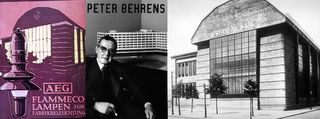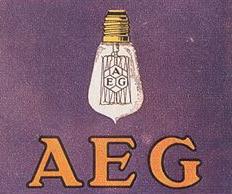Corporate Identity

Peter Behrens designed everything. Born in Hamburg in 1868, he spent his twenties in Munich involved with the Jugendstil (Art Nouveau) movement. It was here that he was one of the founding members of the Deutscher Werkbund in 1907 (DWB, the German Association of Craftsmen), following the success of the third Deutsche Kunstgewerbeaustellung (applied arts exhibit) in Dresden.
He was probably most influential as the former employer of Ludwig Mies van der Rohe, Charles Edouard Jeanneret-Gris (Le Corbusier), and Walter Gropius (founder of the Bauhaus)...but he is best known for his turbine factory in Berlin.

In 1907, Behrens was hired by AEG (Allgemeine Elektricitäts Gesellschaft--that means General Electric Company, more or less) as an artistic consultant. He not only created their logo and advertising, but buildings and products as well. He is considered to be the first industrial designer, if not the first—as the Germans would say—
‘Hett ahff Mahketting’...

AEG (initially called DEG, der Deutschen Edison-Gesellschaft für angewandte Elektricität...the German Edison company for applied electricity--in a long, involved and litigious international attempt to protect Edison's original patents) was founded in 1883 by Emil Rathenau, who had obtained the patent for producing incandescent lamps in Germany. In 1915 he was succeeded by his son Walther, who organized labor and raw materials for the German War machine in the early stages of WWI. Walter Rathenau never stood a chance. He was extremely wealthy, somewhat socialist, involved in negotiations over reparations after the war, secretary of state for the Weimar Republic...but most galling to many in Germany at the time, a Jew. In June of 1922 he was ambushed by several fanatic anti-Semites on his way to work, and killed with a submachine gun. London’s Spectator said it was, ‘as little a surprise as a murder can well be.'

He was painted by Edvard Munch, had a street named after him in Berlin, and graces an U-Bahn (subway) station--in the form of a tile mosaic--at Rathenauplatz in Nuremberg.

<< Home